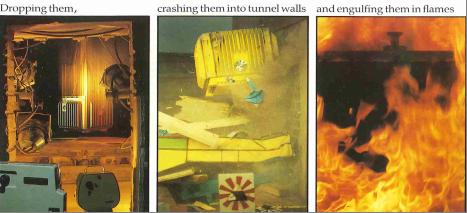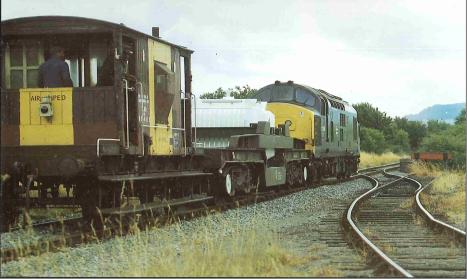How do you prove carrying nuclear waste by rail is safe?

About 30 years ago on the 17th July 1984 millions of people worldwide tuned in to watch a train crash on live TV, a crash with no casualties and on a section of disused railway that made headlines. This was no ordinary crash and the reason why it was so widely watch is explained by an eight page booklet I found whilst re-boxing a donation in our archive.
This was Operation Smash Hit, a demonstration to show how safe the flasks used to carry nuclear waste by road and rail were, by running a 239 ton train into a flask at 100mph.
The demonstration was part of a series of test which involved dropping, crushing and burning the flasks to prove their safety. The train crash was to be the final, most spectacular demonstration, using the heaviest loco British Rail had, on the Old Dalby test track near Melton Mowbray.

Following an eight mile run-up the train hit the flask, which had been laid at an angle in a worst case scenario, and the 22 year old locomotive was almost completely destroyed along with its three carriages. Once the dust and smoke cleared it became obvious that the flask was completely intact, having just lost 0.29 of it 100 pounds of pressure (0.02 bar or practically nothing).
With its safety proved the Central Electricity Generating Board (predecessor to the National Grid) produced a booklet showing the crash, with lots of pictures of the train hitting the flask and bursting into flames, mangled metal and of course the undamaged flask.

Following the test, which feature heavily on the news and in the papers, along with cartoons suggesting a better test would be to run a train in to a BR sandwich, the critics were silence, mostly, and nuclear waste continues to be carried by rail to this day.

The booklet, ‘The CEGB Proves its Point’, that these images are taken from, is available from Search Engine: www.nrm.org.uk/ResearchAndArchive/about.aspx
A full list of our collection can be found on our archive and research page: www.nrm.org.uk/ResearchAndArchive/archiveandlibrarycollections/RailwayCoWorks.aspx
For more information you might want to take a look at our post on ‘How Would British Rail Survive a Nuclear Attack?’ www.nationalrailwaymuseum.wordpress.com/2014/02/20/how-would-british-railways-survive-nuclear-attack/
My Dad and I have a vague memory of viewing the flask and being able to inspect it at the NRM after the event.
Reblogged this on sed30's Blog and commented:
Remember it well
If I recall correctly, one of the buffers from the engine is in the museum store. It has a considerable bend to it!
i was an apprentice in shildon co durham and myself and 4 other lads made the 1st prototype wagon to carry this .
I came across the actual flask at a museum outside the museum door years ago cannot remember where it was has anyone got any if info which museum please
There is an excellent video of this test on youtube. I use the story of this in my training courses on suitable containment for hazardous material. Thanks for the blog!